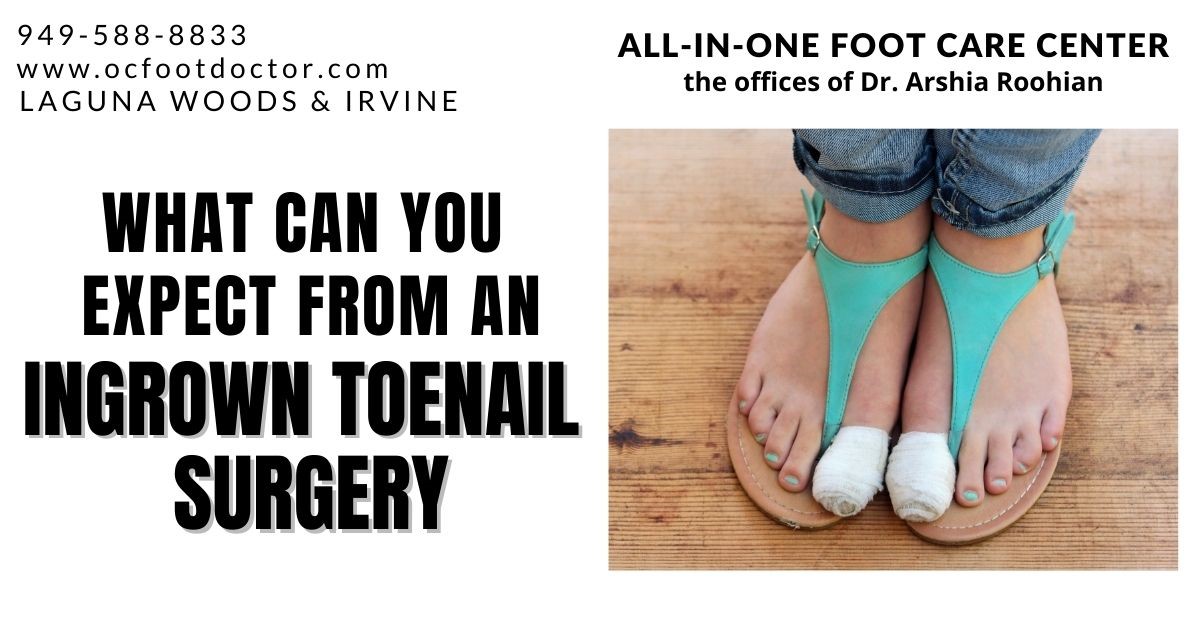What Can You Expect From An Ingrown Toenail Surgery

An Ingrown Toenail Surgery Might Be Needed
When compared to simpler treatments for ingrown toenails, ingrown toenail surgery is seldom recommended to patients.
Even so, surgery may be a better choice in certain situations:
- At-home and conservative treatments have not been successful in treating the condition.
- It is more difficult to treat ingrown toenails if you have a health condition such as diabetes or poor circulation.
- Even after effectively treating ingrown toenails at home, they tend to come back.
In any of the cases above, surgery is not automatically needed, but it definitely becomes an option.
What you need to know before undergoing an ingrown toenail surgery
Outpatient ingrown toenail surgery in our office is typically performed based on a short procedure.
You usually don't need to do anything to prepare for surgery. However, we will discuss it with you in advance if there is anything you need to do.
As a result, we usually perform procedures under local anesthesia, which means that we will numb the area and you will stay awake during the procedure.
In addition to ensuring that your toe is completely numb, we will ensure that your foot isn't in pain. You will still be able to feel touch and pressure on your foot, but it should never be uncomfortable.
A variety of surgical procedures can be used to treat an ingrown toenail
As a general rule, we will be able to perform several types of ingrown toenail procedures based on your symptoms, your circumstances, and any other factors that we will need to take into account.
Here are some examples of different procedures:
- An ingrown toenail can often be treated by performing a small cut right beneath the corner of the nail, leading just before where the nail digs into the skin. You can do this with an ingrown toenail that has been improperly trimmed.
- We perform partial nail avulsions, which are sometimes called "wedge resections," to keep the skin from being further irritated.
- If necessary, a complete nail avulsion can be performed. However, this procedure has some caveats. In order for the toenail to fully regrow, it can take up to a year, and there is a greater chance that it will grow back abnormally, looking misshapen.
- Often, this procedure is considered for patients whose ingrown toenails come back no matter what they do. It follows the same procedure as a complete nail avulsion but also treats the underlying nail bed in preparation for the nail to not grow back.
During some procedures, we may also create an incision in the nail bed to relieve swelling or pus buildup. Infection is usually the reason for this incision.
As part of some procedures, a tight rubber band is placed around the base of the toe. This is intended to slow blood flow.
The Recovery Process after a Toenail Ingrown Procedure
You will usually be dressed and bandaged following surgery on your toe, regardless of the type of procedure.
In order to ensure that everything is in order and the bleeding is not an issue, we will ask you to rest in our offices for a short while. You can then go home.
Please arrange for someone else to drive you home. It will be impossible for you to drive yourself.
There will usually be some discomfort and pain for a couple of days following the procedure. Over-the-counter painkillers should be sufficient to provide comfort. The anesthetic usually lasts 2-3 hours. If you experience more pain after surgery, or if your pain has lasted for more than a few days, please contact us immediately.
Following your surgery, you should rest your foot and limit activities as much as possible in the first few days. Keep your affected foot elevated and keep it off your bed for the first 24 hours. Once your toe has been washed and dried, you can usually rub warm soapy water over it (not rubbing!).
Usually after a few days, you can resume routine activities with low impact. It is best to avoid running and other activities that put a lot of stress on the toes. For about 2 weeks, wear loose-fitting shoes or open-toed ones. By doing this, you will minimize aggravating the toe and allow it to heal faster.
Your aftercare will be discussed with you completely if you require different or additional recommendations.
If you have ingrown toenails, we can help
Ingrown toenails are not the only thing that can be treated with surgery, but when it is needed, it often provides the most long-lasting and effective results.
You can contact our office at 949-588-8833, or visit our website at https://www.ocfootdoctor.com. Our offices are in Laguna Hills, Irvine, Mission Viejo, Aliso Viejo, Lake Forest, Foothill Ranch, and Costa Mesa.
📲 949-588-8833
🏢 24331 El Toro Rd, Suite 370 Laguna Woods CA 92637
🏢Irvine Medical Arts Building 113 Waterworks Way, Suite 250 Irvine, CA 92618
🌐 https://www.ocfootdoctor.com/
The information contained above is intended for general reference purposes only. It is not a substitute for professional medical advice or a medical exam. Always seek the advice of your physician or other qualified health professionals before starting any new treatment. Health information on this website MUST NOT be used to diagnose, treat, cure or prevent any disease without the supervision of your doctor.


